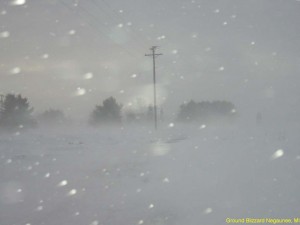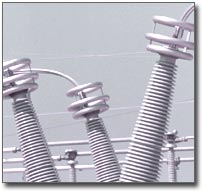Sen. Harry Reid’s Transmission Bill
March 5th, 2009
He says goodbye to Yucca Mountain, and in with a Federal Transmission bill — what a deal…
Yes, it’s that bad. Call everyone…
Clean Renewable Energy and Economic Development Act as introduced
Here’s the DRAFT bill:
CALL EVERYONE AND SAY “NO!”
One thing it would do that’s wrong-headed: If it’s claimed to be “for renewable” it’s presumed “needed.” What’s wrong with that?
1) Rebuttable Presumption is a shift of the burden of proof. On what basis? DUE PROCESS RED FLAGS!
2) What about a commitment to any percentage of renewable changes whether it is needed or not, what about a percentage changes impacts on environment, property values or EMF or or or or or. Electrons don’t care, cannot be ID’d as to generation, and impacts on environment and ratepayers remains the same no matter what’s on it.
3) FERC mandates that transmission be open to all comers — it pretends that it’s “for renewables” when FERC says transmission servces whoever is there, ready to interconnect.
4) What about need:
Nothing about “renewable” claim changes whether it is needed, whether there is a better way, whether those MW could be accomplished through conservation, through load shifting.
Nothing about “renewable” claim address whether renewables could be produced close to load, whether taking nonrenewables off near renewable site or in other locations would make room for renewables (maybe demonstrate this by taking a map with generation and xmsn on it, and highlight coal plants existing and in queue and how many MW there — you’ll see that’s where the transmission is planned)
5) Unreasonably favors that 70%, non-renewable, contrary to policy
6) RES – use of electricity is down, we don’t need MORE, instead we need to shift the percentages to a higher percentage of renewables.
(Maybe offer rebuttable presumption for renewable replacing coal generation and interconnecting at that site? HA!)
Tell them “NO, OVER MY DEAD POLAR BEAR!”
… starting with that dreadful Sen. Amy Klobuchar:
Washington, DC
302 Hart Senate Office Building
Washington, DC 20510
phone: 202-224-3244
fax: 202-228-2186
Metro Office
1200 Washington Avenue South, Suite 250
Minneapolis, MN 55415
Main Line: 612-727-5220
Main Fax: 612-727-5223
Toll Free: 1-888-224-9043
Comments – FERC docket on Green Power Express
February 28th, 2009
A little birdie told me that the Comment period on the Green Power Express rate docket at FERC has been extended to March 6, a week from now.
To find the FERC docket (maybe there’s a quicker way, but this is all I know so far…), CLICK HERE and search for docket ER09-681.
The filing is just too big to upload, but you can see the redacted version here:
What they’re wanting to do is stick their Construction Work In Progress (CWIP) into the rate base… they want to be able to charge us for this, for putting this together!?!?! “Who” is the rate base in this, what are the costs, at what point could they be assessed?
I’m struggling to wrap my pea brain around this, but I’m wondering what the difference is between this and what Xcel got in the 2005 Transmission Omnibus Bill from Hell, other than a much wider rate base:
The rate base that ITC Holdings could spread this over is immense, as opposed to Minnesota’s utilities’ rate base, and the idea of paying for development of this phenomenally stupid idea just galls me… but I’ve got some reading and thinking to do here. Intervenors are lining up to weigh in and fight about it.
And then there’s that 7,000MW of wind in the MISO queue in Illinois, and it’s the Chicago transfer numbers they want to keep secret. Shouldn’t someone tell them that there’s all that wind in Illinois?
I’m printing out this sucker for a winter night’s read…
Check it out — what do you think?
Breakfast with Gary Schiff – Xcel’s Hiawatha Project
February 26th, 2009
Tomorrow a.m., at too early o’clock, there’s a “Breakfast with Gary” panel discussion on Xcel’s Hiawatha Project. Gary Schiff is the 9th ward council rep, here’s the map. Xcel’s proposed Hiawatha Project runs right through the heart of the district — their preferred route is the Midtown Greenway — great, wonderful idea — whatever are they thinking?!?!?!
Moi is on the agenda, so I’ll be up at “even more too early o’clock” to get there, and from the looks of it outside, Ken and Krie might get hitched to a sled. Snow is letting up, and the guy across the street in Wadley’s old house is blowing snow.
Breakfast with Gary Schiff
Panel discussion of Xcel Energy’s Hiawatha Project
Friday, February 27
7:30 to 9 a.m.
Mercado Central
1515 East Lake Street
Bloomington and Lake in Minneapolis
(remember Antiques Minnesota?)
Be there or be square!!
JCSP & UMTDI in the news
February 16th, 2009
More transmission – again in the Wall Street Journal.
Hard to tell which of the alphabet soups this article is about, and I’d say both, it’s about the Joint Coordinated System Plan and the Upper Midwest Transmission Development Initiative — UMDTI! But we know it’s all one and the same.
The article doesn’t really specifically name either “group” and it leaves us wondering just who or what is behind it. This is a good thing — yes, it really is as amorphous as it sounds! What disturbs me, of course, is the “It’s for wind,” because we know better!
At least the WSJ noticed the NYISO and ISO-NE’s objections — here it is again, it’s one of those letters I just can’t get enough of:
The UMDTI is insidious, a cheerleading effort to push transmission through. The way the thing is structured, is, as I said in my comments at the February 11, 2009, meeting, is ABSOLUTELY ASS-BACKWARDS. It’s market driven backwards engineering a transmission solution to support nonexistent need.
Upper Midwest Transmission Development Initiative – HOME PAGE
UMTDI Stakeholder Letter 10-28-08
Stakeholder Responses – LINK – look who the stakeholders are – DUH!
Wind on the Wires Comments … sigh…
UMDTI Stakeholder Letter 12-31-08 (Ed Garvey – MISO)
Dec 30 Draft – Cost Allocation Work Group (Marya White – Commerce)
December 30 Draft – Transmission Planning Work Group (Randy Pilo – PSC-WI)
Wind on the Wires cites many studies:
MISO’s Regional Generation Outlet Study (RGOS)
Transmission planning initiatives by” CapX 2020, ATC, Mid-American and others”
Minnesota RES transmission study
MISO’s MTEP-08 and MTEP-09
Joint Coordinated System Planning Stuey
Eastern Wind Integration Transmission Study
None of these studies are linked — and they’re not on the UMTDI site — let’s see how long it takes to find them.
Now for the more difficult ones… one moment please…
Transmission in NYT today
February 7th, 2009
Matthew Wald has a good piece in the NYT today, good in that it raises some of the issues, but these issues raised need some more digging, can you dig it?
Check this paragraph from the article:
In fact, energy experts say that simply building a better grid is not enough, because that would make the cheap electricity that comes from burning coal available in more parts of the country. That could squeeze out generators that are more expensive but cleaner, like those running on natural gas. The solution is to put a price on emissions from dirtier fuels and incorporate that into the price of electricity, or find some other way to limit power generation from coal, these experts say.
Not “could,” but WOULD “squeeze out generators that are more expensive but cleaner” and adding externalities to coal generation cost would only stop that, would only be a “solution” if it tacked on HUGE costs, far greater than those anticipated by those advocating either Cap & Trade or Tax.
But those of us in transmission are glad to see the driver for new construction exposed, as it was in the MISO Benefits Study by our good friends at ICF:
RTO operational benefits are largely associated with the improved ability to displace generation with coal generation, more efficient use of coal generation, and better use of import potential.
Here’s that MISO study, the above quote comes from the conclusions, p. 83, and is also stated in the intro — THIS IS THE REASON FOR TRANSMISSION, THIS IS THE REASON FOR THE MIDWEST MISO MARKET. Read the study:
ICF’s Independent Assessment of Midwest ISO Operational Benefits
For example, Jose Delgado whining about hwo long it took to get the permit for Arrowhead, what does he expect for a project that was an absurdly obvious ploy for a superhighway for bulk power portrayed as a “local load” need for WUMS? They put together many options in the WRAO report, and selected one, Arrowhead, “3j,” as the be-all and end-all of transmission. That was declared the ONE line that would fix Wisconsin. Then, next thing you know, they still want to do “5” more commonly known as the Chisago project, they want to do “9” in SW Minnesota claiming “it’s for wind” when there’s only 213-302MVA coming off of Buffalo Ridge into the Nobles substation, they do them all because that’s what they want, they can ship bulk power. It’s been so dishonest… Utilities have been so dishonest…
And let’s look at the financing of these lines. CapX 2020 testimony and a powerpoint demonstrate that they don’t have the financing lined up for that $2 billion dollar project. They were working through Lehman Bros. so what does that say? The “Cap” of CapX 2020 is “Capital” and they don’t have it. But because they want it, they’ll make us pay for it. Is something wrong with this picture?
———————————————–
Hurdles (Not Financial Ones) Await Electric Grid Update
“We burn up three years on a line that will take two months to build,” he said.



